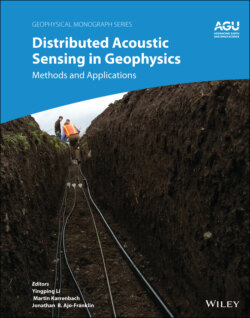Читать книгу Distributed Acoustic Sensing in Geophysics - Группа авторов - Страница 64
3.3.2. Walkaway VSP Survey in Suning Oil Field
ОглавлениеA walkaway VSP survey using the DMOF‐DAS system was conducted in the Suning oil field of CNPC in China. A 1.4‐km‐long armored DMOF cable was permanently cemented behind the casing, which resulted in an excellent coupling between the formation and the sensing fiber cable. Both vibrator (28 ton) and dynamite (16 kg charge) sources were used to generate seismic energy on the surface with different offset distance to the wellhead. The spacing of seismic sources was 40 m, and the farthest source was 8 km away from the wellhead. The DMOF‐DAS VSP data with 2 m spacing were recorded by the DMOF‐DAS system and are presented in Figures 3.9a and 3.9b. It can be seen that high‐quality raw DMOF‐DAS VSP data are obtained, which include clear upgoing and downgoing waves with a very high SNR. The estimated SNR of direct arrival for the zero‐offset DAS VSP data recorded from the armored optical cable cemented behind the casing is about 25 dB. A strong seismic reflector is presented, along with direct shear wave arrivals. Figure 3.9b is the zoomed‐in view on part of raw DMOF‐DAS VSP data and proves the high consistency of polarity and seismic energy attenuated in each channel with depth as expected.
Figure 3.9 Recorded seismic data in well using DMOF‐DAS: (a) DMOF‐DAS VSP data at zero offset with stronger reflector and direct P‐wave and S‐wave arrivals; (b) zoomed‐in view on part of the downgoing wave of (a); (c) VSP raw data display at the offset of 2.5 km; (d) the amplitude spectra of (a); and (e) the amplitude spectra of (c).
Moreover, we measured the raw DMOF‐DAS VSP data for different offset source locations. Figures 3.9a and 3.9c illustrate the raw DMOF‐DAS VSP data when the source locations were near the wellhead and 2.5 km away from the wellhead, respectively. The raw zero‐offset DMOF‐DAS VSP data show a very high SNR (25 dB). While even the source was far away from the well, the direct P‐wave and the direct S‐wave were also observed with lower signal strength. The corresponding amplitude spectra of Figures 3.9a and 3.9c are plotted in Figures 3.9d and 3.9e, respectively, where the red curves represent the spectra of all the fiber section, and the green curves depict the spectra of the effective signal regions. It can be seen that the recorded signals have a wide frequency spectrum and correct amplitude.
